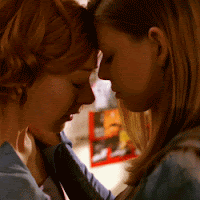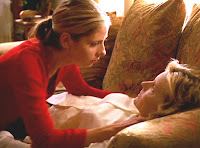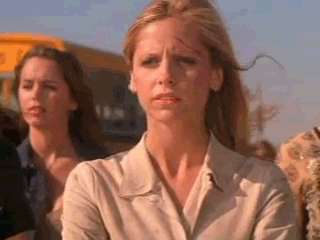Hey! Chris here! It’s a little abnormal for www.deadoakspodast.com to deter away
from posting things about, well, Dead Oaks, but
in light of the twentieth anniversary of TV’s single greatest series—if you’re
thinking Game of Thrones or Breaking Bad, we can’t be friends
anymore—I decided to devote a post to how Buffy
not only helped shape me as a human being in general, but also how it helped shape
the very podcast you (might) tune into every two weeks—Dead Oaks!
To start things off, I have to let you all know a
terrible secret about my childhood: I was a weirdo. It may be hard to believe,
but I was the chubby, nerdy kid in the corner of his fourth-grade classroom,
reading The Shining and drawing
terrible X-Men comics on his notebooks. I was into horror and superheroes while
my classmates were into football and… other things I definitely wasn’t into.
I never fully felt like I fit in with my peers. Little
did I know, a lot of other kids felt
that way, too.
And on March 20th, 1997, a TV series premiered on the
WB network that seemed to practically be designed for me and all those other
freaks and geeks drooling over our comic books and Beast Wars action figures. Buffy
the Vampire Slayer was a risk, in and of itself, because the one thing it
didn’t do was adhere to what most people might think of as “normal.”
For anyone who might have been born in a cave or in a
cult, Buffy told the story of a young
girl, Buffy Summers, who had been chosen to hunt and kill vampires, demons, and
all other forms of supernatural nastiness. With the help of her friends and
watcher (aka, adult mentor), she saved the world over and over, all while navigating
the not-so-subtly-veiled-metaphor-for-hell, high school.
If your eyes are rolling into the back of your head at
how absurd that sounds, I don’t blame you. However, Buffy was a lot more than a bunch of teenagers running around, stabbing
monsters, and occasionally kissing each other. Buffy, though maybe not perfect (especially in its first season—wow,
that was bad!), managed to teach viewers about how life just isn’t fair
sometimes, but you can still be a good person despite it all. Maybe it didn’t
have the same effect on everyone, but the show taught me such
after-school-special abilities as how to grieve, how to accept defeat, and even
how to break out of my nerdy shell and make some friends.
Now, let’s delve a little deeper into how Buffy shaped who I am today…
The Body:
Serious-time-warning: I lost my grandmother, who I was
very close with, the same year Buffy
premiered. And I didn’t handle it well. At ten-years-old, I didn’t understand
death, and I definitely didn’t understand how to process the loss of someone I’d
known and loved my entire life. And, oddly enough, Buffy helped with that. Now, it wasn’t until five years later this
all started making sense to me, but in the fifth season of the show, Buffy’s
mom unexpectedly died. She wasn’t killed by a vampire or vanquished to another
dimension by a witch. Joyce Summers died of a brain aneurism, and there was
nothing Buffy—or any of her friends—could have done to save her. The episode (aptly
titled “The Body”) delved into how even the most powerful and brave of people
can, at times, be completely helpless.
From Buffy first finding her mother’s body in a
cliffhanger at the end of the previous episode, to Anya’s emotional speech
about how she, as a demon who has only inflicted death and never experienced it,
doesn’t understand how to process the emotions she’s feeling, every frame of
the episode felt like a moment from my own life. It was as if Joss Whedon wrote
the episode with my specific loss and sadness in mind.
Now, did Buffy
the Vampire Slayer completely teach me how to handle the loss of a loved
one? No. Would I have made it through that hard time without the show? Yes.
However, I’m glad I had something, even if it was a TV show, to help guide me through a time in my life I never
want to experience again.
Open-Mindedness:
I’m a very open-minded person. If you’re not a
completely terrible person, I don’t care what your religious or political affiliations
are. I don’t care what you look like. I don’t care who you’re attracted to. Be a
good person, and we’ll be just fine.
This is a lesson I feel like Buffy also taught me. Not only did the show represent people—nerds,
outcasts, even minorities—often seen in the world of high school as “lesser” or
“have nots,” it also made them, simply put, cool. Buffy, herself, is the
once-popular queen bee whose life completely turns around because being the
only person with the ability to save the world makes things like high school
popularity contests seem a bit trivial in the grand scheme of things. Willow, a
social-skill-lacking nerd is also the Velma of the group who often saves the
day based on her research skills. The fact she also, eventually, turns into a
badass witch goes further to prove that appearances can be deceiving. Even
Xander, the guy no one wants to date and who always seems to say the wrong
things, ends up being the most loyal friend who, even if only temporarily, gets
to date the girl(s) of his dreams because, believe it or not, being brave is
way hotter than being, well, hot.
 And all this happens before another open-minded moment
in TV history: a main character who also happens to be a lesbian. In the fourth
season of Buffy, after a terrible
breakup with her boyfriend, Willow slowly realizes she’s gay, and eventually
enters a relationship with another soon-to-be main character, Tara. And, even
though the storyline turned some heads, both because it was unusual for the
time, and up until then, Willow had been straight, the show handled the topic
with such nonchalance, it just didn’t seem like that big of a deal—even to my
fourteen-year-old Indiana mind.
And all this happens before another open-minded moment
in TV history: a main character who also happens to be a lesbian. In the fourth
season of Buffy, after a terrible
breakup with her boyfriend, Willow slowly realizes she’s gay, and eventually
enters a relationship with another soon-to-be main character, Tara. And, even
though the storyline turned some heads, both because it was unusual for the
time, and up until then, Willow had been straight, the show handled the topic
with such nonchalance, it just didn’t seem like that big of a deal—even to my
fourteen-year-old Indiana mind.
Though Buffy
certainly wasn’t the first show with a prominent LGBT character, it did exist
in a time before, even if only shortly, having a gay character was “the norm,”
and I personally feel like it helped paved the way for shows to include LGBT
characters as part of the main cast and not walk-on characters that ended up
being part of a punchline.
The Brave and The Bold:
Outside of being a show with some great moral and
emotional moments, Buffy is also a
great show because it wasn’t afraid to step outside the box of what might be
considered “safe” for a TV series. Even for a series about monsters and ghouls,
Buffy was always amping up the suspense
with jaw-dropping moments and surprisingly real-life stories. Hell, the show
killed off the main character (temporarily) in the first season finale. How
many pre-1997 TV shows can you think of with the guts to do that?
In seven short years, Buffy dealt with heavy-hitting topics, and not just the death of a
loved one/parent, as mentioned before. The show dealt with the temptation,
dangers, and risks of premarital sex when Buffy slept with her
vampire-boyfriend in the second season, and as a result, he lost his soul and
went on a killing spree before trying to destroy the world. It dealt with what
happens when the pressures of high school become too much and no one seems to
notice in season three, when semi-regular character Johnathan took a
high-powered rifle into the school clock tower with the intentions of killing
himself—though the audience was led to believe he was going to open fire on
other students. (Side note: this episode was pulled from the air, as it
coincidentally was set to air only weeks after the Columbine massacre in 1999.)
Buffy even dealt with handling rape
(or near-rape) in season six, when an on-again-off-again villain of the series,
Spike, realized he was in love with Buffy, and tried to take advantage of her
in her own bathroom. In the same season (Season six was SUPER dark...), Tara, Willow's girlfriend, is murdered (by a gun and not supernatural means), and after suffering a breakdown of sorts, Willow seeks revenge by murdering her killer in cold blood (before trying to end the world). Not only does that one storyline deal with death and grief, but also the consequences of taking someone's life.
The list goes on and on, quite literally covering 144
episodes worth of heavy, emotional, realistic topics most people wouldn’t associate
with a TV series about vampires.
But wait…
As I wrap up this post (though I could keep writing
for days), you might be wondering how Buffy
the Vampire Slayer influenced my own podcast, Dead Oaks. Well, to that I
ask, have you ever listened to Dead Oaks?
From the beginning, the tagline of Dead Oaks has been:
“There exists a town where all your worst nightmares are bound to come true.”
And while those nightmares may not be as heavy-hitting or meaningful as the
ones presented in Buffy, they are
inspired by Buffy.
 One of the things I didn’t really mention about Buffy the Vampire Slayer is that all
these bad, terrible, monstrous things happen in the nice, little town of
Sunnydale, because Sunnydale was (purposefully) built on top of the mouth to
hell. So, boiling it down to its lowest common denominator, Buffy is about an evil town… not unlike
Dead Oaks. In short, Dead Oaks is my own tribute to Sunnydale and Buffy the Vampire Slayer in general. And
while they differ in almost as many ways as they are the same, and even though
Dead Oaks was also influenced by many, many other pieces of pop culture, the
fact of the matter is, this podcast wouldn’t exist without Buffy.
One of the things I didn’t really mention about Buffy the Vampire Slayer is that all
these bad, terrible, monstrous things happen in the nice, little town of
Sunnydale, because Sunnydale was (purposefully) built on top of the mouth to
hell. So, boiling it down to its lowest common denominator, Buffy is about an evil town… not unlike
Dead Oaks. In short, Dead Oaks is my own tribute to Sunnydale and Buffy the Vampire Slayer in general. And
while they differ in almost as many ways as they are the same, and even though
Dead Oaks was also influenced by many, many other pieces of pop culture, the
fact of the matter is, this podcast wouldn’t exist without Buffy.
And for that, all I can really say to the creators,
actors, and writers of the show, is… thank you.





Comments
Post a Comment